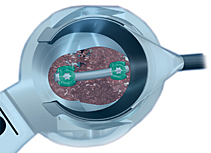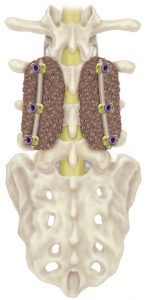Posterolateral lumbar fusion is spine surgery that involves placing bone graft between elements in the back, or posterior, of the spine, leaving the disc space intact. The procedure may be performed using minimally invasive surgical techniques.
What Is Posterolateral Lumbar Fusion?
A posterolateral fusion operation is similar to a posterior lumbar interbody fusion (PLIF); however, instead of removing the disc space and replacing it with a bone graft, the disc space remains intact and the bone graft is placed between the transverse processes in the back of the spine. This allows the bone to heal and stabilizes the spine from the transverse process of one vertebra to the transverse process of the next vertebra.
In a posterolateral fusion, pedicle screws and rods also may be implanted to stabilize the spine until the bone graft heals. A single-level fusion fuses two vertebrae and usually uses four screws and two rods. A two-level fusion fuses three vertebrae and uses six screws and two rods.
Traditional, open spine surgery involves cutting or stripping the muscles from the spine. Today, a posterolateral fusion can be performed using minimally invasive spine surgery, a treatment that involves a smaller incision and muscle dilation, allowing the surgeon to gently separate the muscles surrounding the spine rather than cutting them.
Why Do I Need This Procedure?
A posterolateral fusion may be recommended as a surgical treatment option for patients with a condition causing spinal instability, such as degenerative disc disease, spondylolisthesis or spinal stenosis, that has not responded to conservative treatment measures (rest, physical therapy or medication). The symptoms of spinal instability may include pain, numbness and/or muscle weakness.
Your surgeon will take a number of factors into consideration before recommending posterolateral fusion, including the condition to be treated, your age, health and lifestyle and your anticipated level of activity following surgery. Please discuss this treatment option thoroughly with your spinal care provider.


How Is Posterolateral Lumbar Fusion Performed?
The Operation
The operation is performed with the patient positioned on his or her stomach.

Spinal Access and Bone Removal
First, your surgeon will make a small incision in the skin of your lower back. Depending on the instrumentation to be used, the incision could be as small as approximately 3 centimeters. In a traditional posterolateral fusion, a 3- to 6-inch incision is typically required.
The muscles surrounding the spine will then be dilated to allow access to the section of spine to be stabilized. After the spine is accessed, the lamina (the “roof” of the vertebra) is removed to allow visualization of the nerve roots. The facet joints, which are directly over the nerve roots, may be trimmed to give the nerve roots more room.
A bone graft is then laid between the transverse processes in the back of the spine. Screws and rods are implanted to stabilize the spine while the treated area heals and fusion occurs.
Your surgeon will then close the incision, which typically leaves behind only a small scar or scars.

How Long Will It Take Me To Recover?
This minimally invasive procedure typically allows many patients to be discharged the day after surgery; however, some patients may require a longer hospital stay. Many patients will notice immediate improvement of some or all of their symptoms; other symptoms may improve more gradually.
A positive attitude, reasonable expectations and compliance with your provider’s post-surgery instructions all may contribute to a satisfactory outcome. Many patients are able to return to their regular activities within several weeks.
To determine whether you are a candidate for minimally invasive surgery, talk to your provider.
Are There Any Potential Risks Or Complications?
All treatment and outcome results are specific to the individual patient. Results may vary. Complications such as infection, nerve damage, blood clots, blood loss and bowel and bladder problems, along with complications associated with anesthesia, are some of the potential risks of spinal surgery. A potential risk inherent to spinal fusion is failure of the vertebral bone and graft to properly fuse, a condition that may require additional surgery.
Please consult your physician for a complete list of indications, warnings, precautions, adverse effects, clinical results and other important medical information that pertains to minimally invasive posterolateral lumbar fusion.

